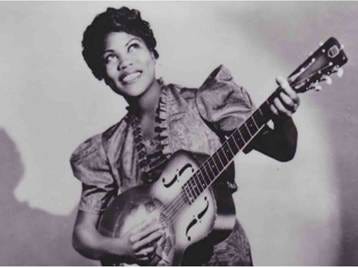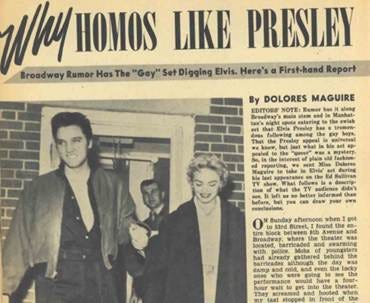As a child, Elvis would rush after school each day to listen to a singer on the radio. He never missed WELO’s daily half-hour of black gospel. The singer was Sister Loretta Tharpe, and she would become both an inspiration and a template for his future career as America’s Shaman.
Why was Tharpe so influential on the child who would be King of Rock’n’roll?
We can start with how Elvis admired Tharpe’s life trajectory: a gospel singer from Arkansas came from a background of agricultural poverty and rose to international fame.
Tharpe was born Rosetta Nubin in 1915 in Cotton Town, Arkansas. She was a music prodigy who began playing the guitar at the age of six. Performing with her mother in a religious troupe across the South, she developed a unique style that blended gospel with electric guitar. In 1938, at the age of 23, she caught the attention of legendary Jazz artist Cab Calloway while performing on the streets of New York, leading to an invitation to play at the Cotton Club. Tharpe’s electric personality and profound talent quickly made her a success.
She signed with Decca Records, becoming the first gospel artist featured by the label. Struggling to categorize her sound, Decca promoted her as “spirituals in swing,” allowing Tharpe to combine religious lyrics with dance music —a groundbreaking move at the time. Tharpe conquered the charts and was accepted by white audiences in the 1930s and 1940s (even appearing in a photo essay on Life magazine in 1941, a rarity for African American celebrities).
What better example in the poor South for any dreamer, a person who could attain social mobility, wide social acceptance, and artistic freedom? She was the dream come true in the nightmare of the Great Depression that tormented Elvis and his family. Moreover, Tharpe provided the model Elvis would later employ. I write in The Occult Elvis, she did it by:
“…turning gospel music into cabaret tunes, being as outrageous and as sexual as she felt. She was flashy in dress and swung a guitar on stage like a warrior.”
Gospel musician Ken Romanowski described Tharpe as “flamboyant, histrionic, magnetic, and precocious.” The singer was an innovator who synthesized genres and was unafraid to express her spirit through her body on the stage.
Yep, Tharpe was the Elvis before Elvis.
And like Elvis, Tharpe would be criticized for her extroverted and transgressive performances. Music historian Anthony Heilbut stated that Tharpe shifted the sacred into the profane, a trend later adopted by Elvis and other early rockers, who spiced up country and gospel with elements of devilish blues, sexual innuendo, and Dionysian gyrations.
Tharpe’s art was as alien as it was welcoming to a lost home for seeking souls, pushing and destroying many status quo boundaries. As writer Nigel Patterson wrote:
…her music knew no boundaries, and she perfected her own style of bending notes and phrasing words. She entered the stage with brightly dyed flame-red hair and her guitar slung over her shoulder. Her typical pose was standing guitar in hand not unlike Elvis would do in the 1950s. Rosetta’s different versions of the same song could range from big band accompaniment to boogie woogie, country style or a church choir backing.
As seen, Tharpe was a Philosopher’s Stone for Elvis, whose favorite genre was gospel (as long as he could inject his own ecstatic, rebellious essence). The King would establish his Tharpe-esque alchemical laboratory in the mid-fifties. As I write in my book:
In the 1950s, gospel and the blues, Paradise and Hades, blended to usher in a new age, and Elvis would be the greatest advocate and disseminator of this merged shamanistic tradition, Hell-bent and Heaven-sent. For decades, religious critics claimed that Pentecostals had pushed the boundaries of decency by mixing sex and salvation, and now it was realized in Elvis and his rock music.
Thorpe has been dubbed the Godmother of Rock’n’roll. Prophetically, her first big hit was “Rock Me” (1938). She is sometimes credited with being the first musician to employ slide and distortion on the electric guitar, and her sound was the direct ancestor of other Black guitarists, such as Muddy Waters, Chuck Berry, and B.B. King. Elvis himself covered many Tharpe’s songs, including “Up Above My Head,” “Just A Closer Walk With Thee (This Train) = ‘My Babe’” and “Down By The Riverside.” Beyond the King, her music was an influence on such rock superstars as Eric Clapton and Bob Dylan.
Another element Elvis borrowed from Tharpe was likely androgyny. Although she married twice to men, evidence exists that she was bisexual through her relationship with singer Marie Knight, whom she met in 1946. They recorded “Up Above My Head” and teamed up to go on tour. The women worked together until 1950, and rumors circulated about their affair, even if Tharpe married a third time in 1951. However, Knight was a close companion until the day she died.
Of course, Tharpe never admitted to any genderbending, especially in her era, and Elvis wasn’t bisexual. Nevertheless, her animus-soaked aura on stage was surely apparent to the perceptive Elvis and was part of her stage charisma.
In The Occult Elvis, I explain how Elvis tapped into the powerful archetypal forces of the androgyne, making himself into a more vulnerable, softer, and mystical male on stage —a sort of modern-day Orpheus that was irresistible to women. The idea of a human being attaining power over themselves and society by drawing upon balanced male (animus) and female (anima) aspects is an ancient motif, whether it’s Zeus splitting the being Hermaphrodite into male or female out of fear, or the supreme Adam Kadmon in Kabbalistic lore. For music, this balancing, Yin-Yang power elevated Elvis and Tharpe. The androgynous vibe would be tapped into repeatedly in rock music, from the Beatles to David Bowie, from Michael Jackson to Lady Gaga.
Beyond the esoteric, the point is that gender bending is an integral part of rock music in its various stages, a potent spice in its stew of shamanism, mutiny, and ecstasy.
Tharpe never reached the stratosphere of fame that Elvis or other founders of rock ‘n’ roll achieved. In the fifties, gospel and blues waned in popularity. She continued to perform but lived in relative poverty until she died in 1973. In 2018, though, she was inducted into the Rock’n’roll Hall of Fame.
Elvis was shaped by many other influences, without a doubt, but Tharpe has to be a primary one. Kids don’t rush home from school unless there awaits love, magic, or something that just self-actualizes their senses.









She really is a powerful artist as well!